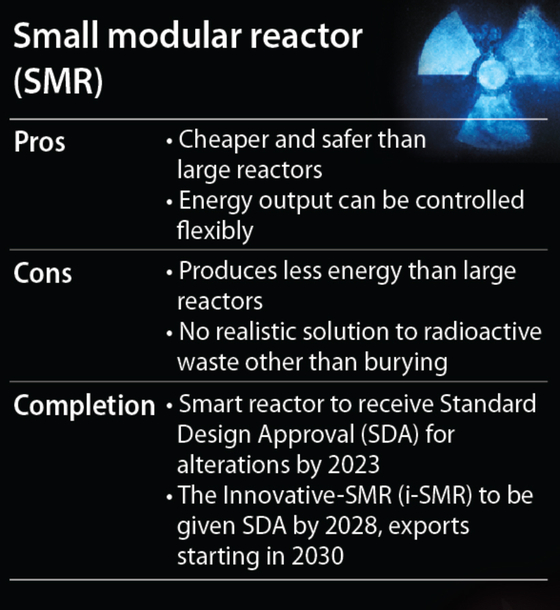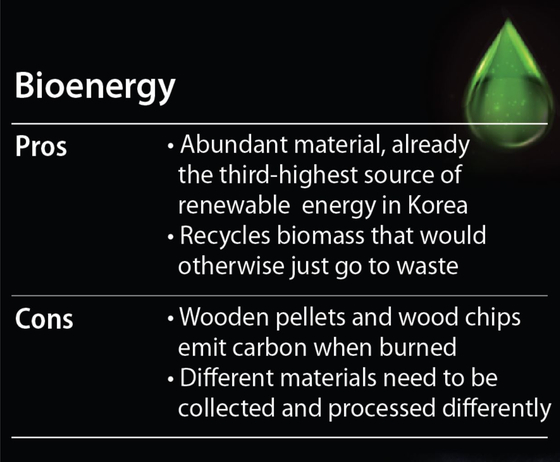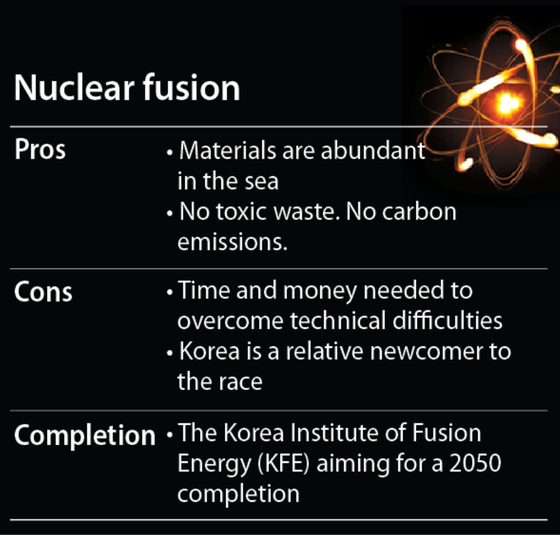[CHANGING WORLD] Small nuclear reactors and other tech may help reduce emissions
![A model of the Smart (System-integrated Modular Advanced Reactor) small modular reactor (SMR), invented by the Korea Atomic Energy Research Institute (Kaeri), is on display at the ″2016 Korea Atomic Industrial Forum″ held in Busan. [KAERI]](https://koreajoongangdaily.joins.com/data/photo/2021/10/28/51fd7377-81e0-420e-a919-c676213b33bd.jpg)
A model of the Smart (System-integrated Modular Advanced Reactor) small modular reactor (SMR), invented by the Korea Atomic Energy Research Institute (Kaeri), is on display at the ″2016 Korea Atomic Industrial Forum″ held in Busan. [KAERI]
FUTURE TECHNOLOGIES
Three Mile Island. Chernobyl. Fukushima. Nuclear reactors are potentially very dangerous.
They are also incredibly efficient and produce no emissions. Wind drops. The sun goes down. Nuclear plants keep on generating electricity year in, year out regardless of the weather or the time of day.
It's not renewable. Uranium must be mined. But it is a great solution for a world seeking to lower the amount of carbon in the atmosphere.
According to some studies, nuclear power is actually cleaner than wind and solar. If only it were not for the meltdowns and the radiation.
One possible way of getting nuclear over the line and more acceptable to people who worry about these sorts of things is small modular reactors (SMR) technology.
The actual reactor part of these units fits in about a 2-meter cube, and the reduced volume disproportionately lowers the risks associated with the energy source. They are far safer than they are small.
Proponents argue that SMRs are the missing piece in the renewable puzzle, providing the base load required to get solar and wind to work without generating carbon dioxide in the process.
Other unlikely energy sources are being explored to complete the picture and allow Korea to become carbon neutral in a balanced and cost-effective way. They range from new unexpected twists on old tech to the downright bizarre, and at least a few will likely be utilized in some shape or form as the realities of the task at hand sink in.
Korea’s energy future will not be a simple one of wind and sun, but a patchwork of solutions where weaknesses and strengths of each allow for the realization of a workable and stable whole.
![Visitors look at a model of the Smart (System-integrated Modular Advanced Reactor) small modular reactor (SMR) invented by the Korea Atomic Energy Research Institute (Kaeri) at the ″2016 Korea Atomic Industrial Forum″ held in Busan. [JOONGANG ILBO]](https://koreajoongangdaily.joins.com/data/photo/2021/10/28/909d8978-c4e6-48f0-b23c-6cd4c2a177c3.jpg)
Visitors look at a model of the Smart (System-integrated Modular Advanced Reactor) small modular reactor (SMR) invented by the Korea Atomic Energy Research Institute (Kaeri) at the ″2016 Korea Atomic Industrial Forum″ held in Busan. [JOONGANG ILBO]
Nuclear power, cheaper and safer
Korea is one of the leaders in the SMR race.
According to the International Atomic Energy Agency (IAEA), SMRs refer to reactors with a capacity of under 700 megawatts. SMRs use smaller reactor units, which leads to lower costs, fewer risks and lower overall risk than conventional large reactors.
They are modular, like Legos. Units can be built separately and then combined to achieve greater output.
Because smaller reactors generate smaller amounts of energy, they give off less heat in the event of accidents. Large reactors need coolants to remove the residual heat, referred to as decay heat, which continues after fission ceases.
The 2011 Fukushima Daiichi nuclear disaster was the result of that safety system failing due to an earthquake and tsunami. SMRs can be shut down without extra coolants.
Should the reactor vessel be compromised in extreme situations, the fallout zone is the immediate area. For large reactors, a 10-to-30 kilometer radius can be rendered uninhabitable for decades or centuries.
"With SMRs, it's possible to eradicate any 'fatal' hazards like the Fukushima incident," said Kim Yong-hee, a professor of nuclear and quantum engineering at KAIST.
"It's also been stated by various organizations, such as the International Energy Agency [IEA] and the Intergovernmental Panel on Climate Change [IPCC], that nuclear power plants play a key role in overcoming the global environmental crisis. The IPCC has also proven that greenhouse gas emissions from nuclear power plants are actually lower than any other energy source, including renewables such as wind power."
There are around 70 SMR designs being developed globally, only a handful of which are actually in use. The United States is taking the lead in the race.
Korea has been actively developing SMRs for about a decade.
In July 2012, the Korea Atomic Energy Research Institute (Kaeri) received Standard Design Approval (SDA) from the Korean government for Smart (System-integrated Modular Advanced Reactor), the first in the world. Research began in 1997.
According to Kaeri, Smart produces one percent of the energy of conventional nuclear power plants, but it is one thousand times less dangerous.
A more advanced SMR is under development to increase the utility of SMRs.
Kaeri, Korea Hydro & Nuclear Power (KHNP), government officials and parliament members held the "Innovative SMR [i-SMR] National Assembly Forum" in April, vowing to achieve approval by 2028 and start exporting from 2030.
"We have filed a request with the government to review our plans regarding the i-SMRs as well as other renewable energy and nuclear plants," Jeong Jae-hun, KHNP president, told the National Assembly on Oct. 12. "We're already getting started with the initial designs of the SMR and hope for the government to give us positive feedback on investment."

The two most widely known sources of renewable energy — solar power and wind power — are greatly affected by weather conditions. Because SMRs are smaller and thus easier to control, their output can be reduced when there's abundant sunlight or wind.
"The i-SMR also aims to make the facility available for hydrogen production as well as thermal storage, so their use goes beyond just being nuclear power plants," said Lee Dong-hyung, head nuclear energy researcher at Kaeri. "When there's enough renewable energy being made, the surplus energy from SMRs can be used to produce hydrogen or stored."
The assessment to make alterations to the SDA earned by Smart also began in August. The evaluation is expected to end by late 2022 or early 2023, after which development and construction can begin.
"We are working together with Saudi Arabia to export Smart to other countries," Lee said. "If we succeed, then Korea will be the first country in the world to export SMR designs."
Local companies are taking part in the SMR competition. Hyundai Engineering and Kaeri signed a memorandum of understanding with the government of Alberta, Canada, to co-construct SMRs. Korea's Ministry of Trade, Industry and Energy and the Korea Engineering & Consulting Association will help fund the project. No date has been set for completion.
“We carried out research and various projects regarding nuclear energy in the past, which is why we're interested in developing SMRs are well," said a spokesperson for Hyundai Engineering. "The study of SMRs is rising in popularity all over the world. We hope to have some tangible results after this collaboration."
Another company in the race for SMRs is Doosan Heavy Industries & Construction, which vowed to focus on developing the technology needed to construct SMRs. The company first jumped into the SMR business in 2019, signing an agreement with Tigard, Oregon's NuScale Power in April that year to provide them with the nuclear modules when NuScale Power builds its first SMR plant in 2026.
Last month, Doosan signed an agreement with Greenbelt, Maryland's X-Energy to co-develop its Xe-100 Generation-IV SMR. Doosan Heavy Industries & Construction will contribute to the design, production and renovation of X-Energy's SMR facility.
"Doosan has been running a nuclear research team for a long time, and we will be using the knowledge we have to bring SMRs closer to realization," said a spokesperson for Doosan Heavy Industries & Construction.
![Pile of fir wooden pellets in flames [SHUTTERSTOCK]](https://koreajoongangdaily.joins.com/data/photo/2021/10/28/d9be7e64-ae72-43b7-a68f-ab3084c766a3.jpg)
Pile of fir wooden pellets in flames [SHUTTERSTOCK]
Making use of bio waste
Bioenergy is the No.3 source of renewable energy in Korea in terms of maximum capacity, following energy generated from waste materials and solar power, but it's also a much-debated source of energy. It is not clear whether it is environmentally friendly.
Bioenergy covers all energy generated from biomass, which refers to material from plants and animals. This ranges from generating heat energy from burning wood or agricultural residue, to extracting gas emitted during plant fermentation or producing oil from animal fat.
But because most bioenergy generation currently depends heavily on burning wood, which is imported, environmentalists often challenge the eco-friendliness of the energy source.
As of 2019 in Korea, the largest source of bioenergy comes from burning wooden pellets and the third largest source was bio-SRF (solid refuse fuel), otherwise known as wood chip fuel (WCF). And 95 percent of wooden pellets were imported last year, according to the Korea Energy Agency.
A coalition of 500 researchers globally sent a letter in February urging world leaders to stop "increasing use of wood for energy," explaining that "harvesting and burning trees will increase global warming for decades to centuries." Recipients of the letter included President Moon Jae-in and U.S. President Joe Biden.
Bioenergy should be generated from waste that would otherwise not be used, and the technology needed to develop bioenergy is much less complex than for other renewable energy sources, according to experts.
Biogas, biodiesel and bioethanol are being developed. Korea is producing its own biogas and biodiesel but not bioethanol, which is mostly produced in countries that cultivate large amounts of sugar or corn, such as the United States and Brazil.

"Bioenergy production emits 40 percent less carbon compared to fossil fuels," Kim said. "It's true that bioenergy production makes carbon, but so does simply disposing of the waste. If energy can be created in the process, that's a more environmentally-friendly method of making use of it. We must keep in mind that there's no way of producing energy with zero carbon emissions."
Because biomass waste is created from diverse materials, it's easy for companies to take part in developing their own technology to generate bioenergy.
Liquor manufacturer Hite Jinro, for example, said on Oct. 13 that it replaced water waste treatment devices with internal circulation (IC) reactors, which purify waste with microorganisms, and now uses the byproduct biogas as heat fuel.
The company said it has cut 4,020 tons of greenhouse gas emissions over the last two years, equivalent to the amount of carbon absorbed by a pine forest the size of 150 football fields.
It's also possible to make energy from cattle excrement.
Daehyun Green, a small agriculture company located in North Jeolla, was chosen by the Ministry of Agriculture, Food and Rural Affairs to lead a pilot project to generate energy from cattle excrement in 2013. It collects an average of 250 tons of waste from nearby farms, processes the waste and turns it into 15,000 cubic meters of biogas a day, earning 2 million won every day.
Biodiesel is also gaining popularity.
LG Chem will establish a company with Dansuk, a local company specializing in the production and development of biodiesel, and start operating the new company's plants in 2024. The new company will be Korea's first-ever specializing in hydro-treated vegetable oil (HVO).
HVO is a type of bio oil that does not freeze at lower temperatures and can be used to fuel both cars and airplanes, a "next-generation" biofuel, according to LG Chem.
"We are going to focus on the biodegradable and bio-based plastic businesses in order to raise the sustainability of our major sectors," a spokesperson from LG Chem said.
Other companies are rolling out plans to join the move toward bioenergy in the future.
Samsung C&T and S-Oil signed a hydrogen and biofuel partnership on Sept. 17, promising to co-develop clean hydrogen and ammonia, along with biofuels, including biodiesel and bio air fuel. The agreement came as a part of S-Oil's focus on going carbon neutral and delving into new energy.
"Our trading businesses give off residual biomass such as palm oil, which we will provide to S-Oil to be developed in useful ways in the future," a spokesperson from Samsung C&T said. "We will be seeking ways to make our business more environmentally-friendly in the future.
![The Kstar, or the Korea Superconducting Tokamak Advanced Research, developed by the Korea Institute of Fusion Energy (KFE) successfully contained plasma for 20 seconds last year. The facility is located in Daejeon. [NEWS1]](https://koreajoongangdaily.joins.com/data/photo/2021/10/28/1b11e17e-d2fb-4102-8d1e-43ab4c7117c1.jpg)
The Kstar, or the Korea Superconducting Tokamak Advanced Research, developed by the Korea Institute of Fusion Energy (KFE) successfully contained plasma for 20 seconds last year. The facility is located in Daejeon. [NEWS1]
Near future
SMRs are close to realization and bioenergy technology is improving by the day. Other energy technologies are being developed further out, possibly decades.
This includes sci-fi ideas like extracting energy from black holes or changing the molecular structure of existing materials so they emit no residual gas or debris when burned.
If aerospace technology advances far enough, solar panels could be installed in space so power can be generated regardless of the weather or time of day. Energy could even be captured from solar wind, high-energy particles emitted from the sun.
While these developments remain theoretical, there's an energy source referred to as "the dream energy" and showing potential in Korea: nuclear fusion.
Nuclear fusion reactors generate electricity by collecting energy that is emitted when two atomic nuclei combine to form a heavier nucleus. Nuclear fusion is the process that powers stars, like the sun, hence the nickname "artificial sun" commonly used to refer to nuclear fusion reactors.

The Korea Institute of Fusion Energy (KFE) built Kstar, or the Korea Superconducting Tokamak Advanced Research, in September 2007, the first fusion reactor in the world to be built with Nb3Sn superconductors. A Tokamak is a donut-shaped containment vessel that holds the fuel in a magnetic field as fusion is taking place.
In July 2008, it succeeded in artificially generating plasma, a state of matter where electrons and nuclei move freely without being bound to each other. A nuclear fusion reactor must be able to maintain the plasma state at over 100 million degrees Celsius (180 million degrees Fahrenheit) for 24 hours for it to be considered successful.
Last year, Kstar contained plasma for 20 seconds, bringing the goal closer to realization but a long way from the 24-hour milestone. The KFE wants Kstar working by 2050 and generating electricity.
Korea is also taking part in the ITER (International Thermonuclear Experimental Reactor) project as one of 35 countries. The ITER will be the world's biggest nuclear fusion reactor when it's built in 2025.
"Nuclear fusion isn't something that a single country or entity can achieve on its own," said a spokesperson from the KFE. "It's a field of research that needs all our collective knowledge and an important technology to meet the carbon-free goals that governments around the world are taking up. We are taking part as a member of that global alliance."
Scientists and engineers all over the world are constantly researching new ways to generate energy, because it's important not to "put all eggs in one basket" when it comes to energy, according to Jerng Dong-wook, a professor who teaches at the school of energy systems engineering, nuclear department at Chung-Ang University.
"No energy source is perfect, and it's dangerous to depend on one particular method," he said. "We need to meet the zero-carbon goal but at the same time sustain the level of life for everyone in the world. And the way to do that is to develop various ways to generate energy that tend to the different needs of the environment and energy supply."

BY YOON SO-YEON [yoon.soyeon@joongang.co.kr]










with the Korea JoongAng Daily
To write comments, please log in to one of the accounts.
Standards Board Policy (0/250자)